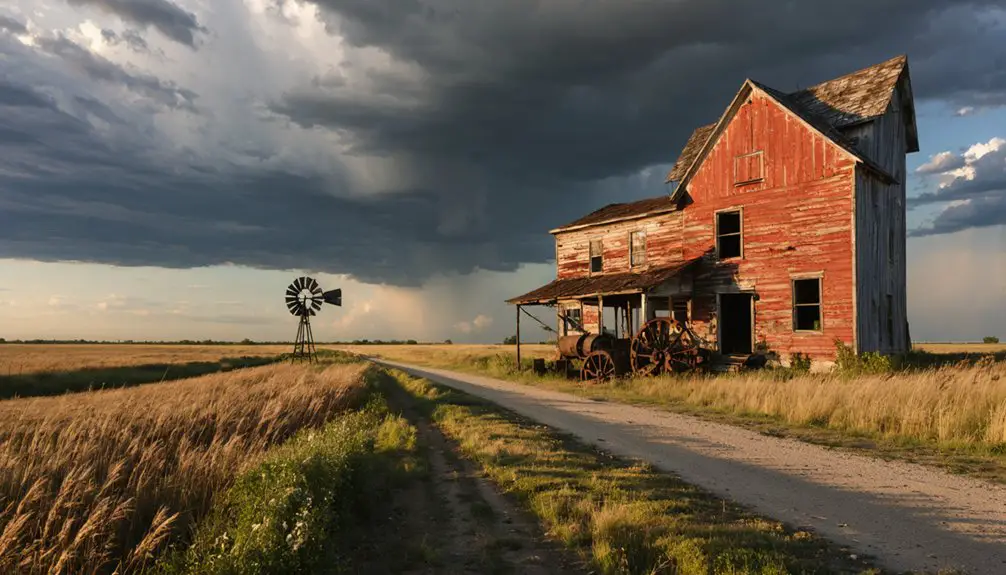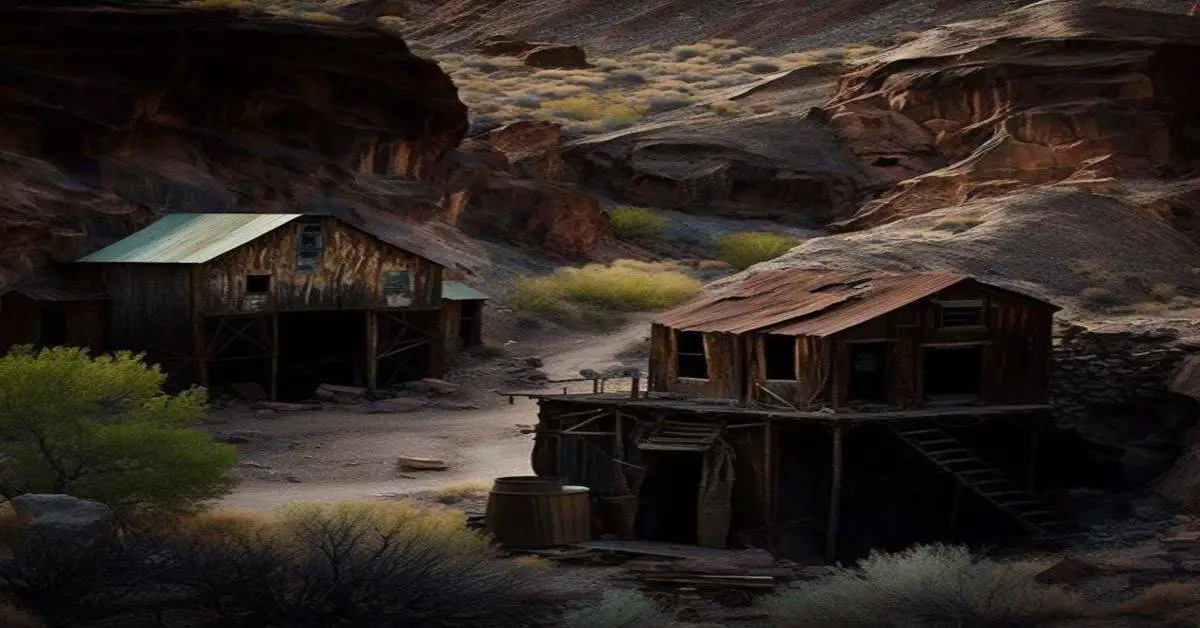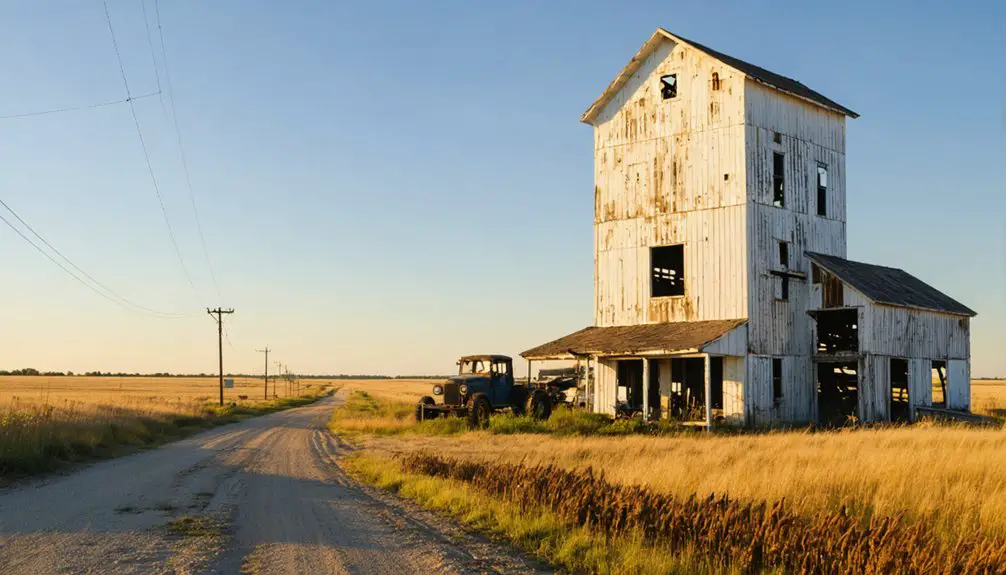You’ll find Melville’s remnants along North Dakota’s prairie, where this former railroad town thrived in the 1870s. The Northern Pacific Railroad’s Jamestown branch transformed it into a bustling agricultural hub, shipping over a million bushels of grain annually. By the 1930s, the Great Depression and Dust Bowl reduced the population to just 35 residents. Today, weathered structures and a 192-memorial cemetery tell stories of pioneer resilience and railroad prosperity.
Key Takeaways
- Melville was established in the early 1870s as a railroad town, becoming a significant trade hub with grain elevators and general stores.
- The Great Depression and Dust Bowl of the 1930s devastated the community, causing population decline to just 35 residents.
- Most original structures have collapsed or been removed, with only a few deteriorating buildings remaining as testament to its history.
- The town’s cemetery contains 192 documented memorials, maintained by volunteers and descendants through informal preservation efforts.
- Public roads allow viewing of abandoned structures, though many areas are restricted due to safety concerns and “no trespassing” signs.
The Birth of a Prairie Settlement
As the Dakota Territory opened for settlement in 1861, Melville emerged as one of many hopeful prairie communities in northern North Dakota’s rolling landscape.
You’ll find its roots in the great homesteading wave of the 1880s, when over 100,000 pioneers pushed into the northern plains seeking a fresh start.
The settlement challenges were fierce – you’d have battled harsh winters, towering snow banks, and the isolation of frontier life. The Northern Pacific Railroad played a crucial role in bringing settlers and supplies to the region.
Yet the pioneers persevered, building a rich cultural heritage as German, Scandinavian, and other European immigrants staked their claims.
They’d gather in barns and homes for Sunday school, organize horse races and baseball games, and warm themselves around cook stoves in simple houses.
Despite the brutal climate, they found freedom in Melville’s fertile prairie soil, establishing farms that would sustain generations.
Railroad Days and Early Growth
When the Northern Pacific Railroad extended its Jamestown branch through the region in the early 1870s, Melville’s destiny changed forever.
Originally named Newport after the railway’s treasurer, the settlement quickly established itself as a crucial trade hub along the expanding rail network. You’d have found a bustling community where grain elevators, lumber yards, and general stores served the surrounding farmlands.
The railroad expansion transformed Melville’s economic landscape, connecting local farmers to major markets in Duluth and Minneapolis.
Trade connections flourished as the town sat strategically between the Northern Pacific and Soo railway lines, with the significant junction at nearby Carrington linking multiple branches.
The railway’s presence attracted merchants, sparked development, and shaped settlement patterns that would define Melville’s peak years of prosperity. Like many places named Melville, this location required careful disambiguation to distinguish it from similarly named settlements.
Local farmers benefited from the town’s location, shipping over one million bushels of grain annually through the region’s rail network.
Daily Life in Old Melville
Life in old Melville centered around the daily rhythms of an agricultural community, where families shared both work and social bonds.
You’d find multiple generations living together in modest homes built from local materials, working side by side on farms and sharing daily chores.
Community gatherings at the general store, post office, and churches kept everyone connected.
Your children would have attended the two-room schoolhouse, learning practical skills alongside basic education.
Family traditions revolved around seasonal work – from spring planting to fall harvest – with neighbors helping neighbors through each challenge.
You’d shop at local businesses, communicate through the telegraph office, and travel mostly by horse and wagon on dirt roads.
The railroad depot served as your link to the wider world, bringing supplies and news to this tight-knit farming town.
The local John Deere dealership provided essential farm equipment and supplies to support the agricultural economy.
Many residents shared their personal histories through comments and stories, preserving memories of life in North Dakota’s small towns.
The Slow Decline Years
You’d hardly recognize Melville during its decline years, as the Great Depression and Dust Bowl droughts dealt crushing blows to local farming families in the 1930s.
The town’s younger residents steadily moved away to larger cities in search of better opportunities, while mechanization meant fewer workers were needed on the increasingly consolidated farms.
Much like the nearby town of Arena, the area saw a dramatic population drop to just 35 residents by the mid-1930s.
What began as a trickle of departures in the Depression era became a flood by mid-century, leaving behind aging residents, empty storefronts, and deteriorating buildings that once housed thriving businesses. The emergence of ghost towns across agricultural states became increasingly common as technological advances allowed fewer farmers to manage larger tracts of land.
Population Exodus Patterns
Despite Foster County’s promising growth in the early 1900s, Melville’s population began a gradual but persistent decline starting in the 1940s, following the county’s peak of 6,353 residents in 1930.
The population dynamics revealed a steady exodus, with significant drops ranging from -8.3% to -13.6% in subsequent decades through 2010. The shift mirrored broader trends seen in Census Bureau data showing demographic shifts across rural areas.
You’d have noticed the rural migration patterns favoring North Dakota’s urban centers like Bismarck, Fargo, and Grand Forks, while Melville and similar rural communities lost their younger residents to these metropolitan areas.
This outward flow weakened the town’s social fabric – once-thriving clubs, lodges, and seasonal events gradually disappeared.
The declining population made it harder to sustain essential services, creating a cycle of diminishing infrastructure that further accelerated the exodus from this once-vibrant rural community. The town’s location along the James River flow contributed to its early settlement success but couldn’t prevent its eventual decline.
Economic Hardships Mount
When the Great Depression struck Melville in the late 1920s, it released a devastating chain of economic hardships that would plague the community for decades.
You’d have seen mounting farm debt crush local families as wheat prices collapsed and drought conditions withered crops. Local banks, once pillars of economic resilience, began closing or merging as financial stress intensified throughout the region.
The shift to tractors from horse-drawn equipment pushed out smaller operators, while those who survived often depended on cooperative efforts and insurance programs. North Dakota’s real GDP plummeted during this era, reflecting the severe economic distress across the state.
You’d have witnessed Melville’s business district contract as merchant freight dwindled and sales volume plummeted.
Despite these challenges, the community fought back – local banks occasionally helped distressed farmers reclaim their land, while social gatherings continued at places like Hawks Nest, though with diminished resources.
What Remains Today
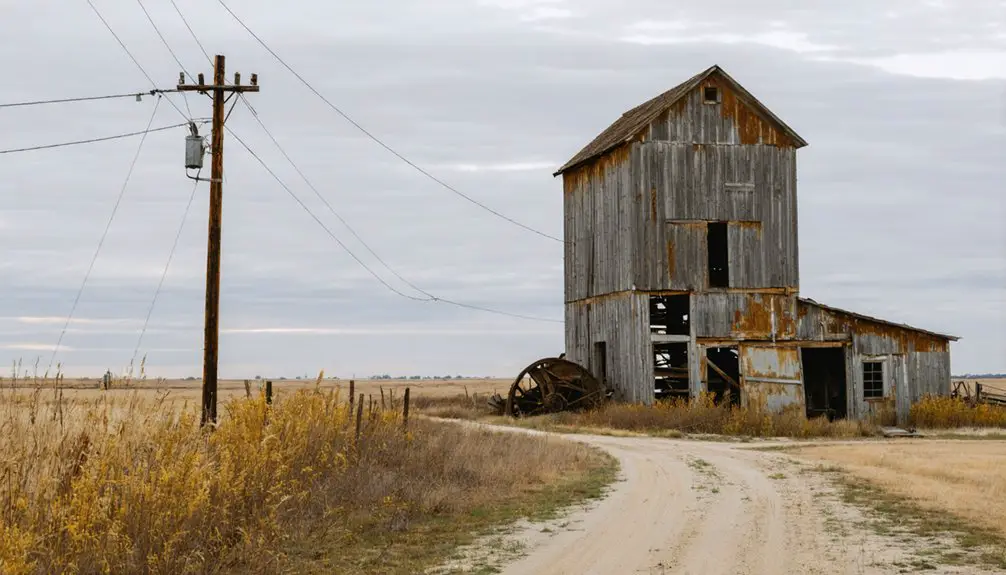
If you visit Melville today, you’ll find little evidence of the once-bustling prairie town beyond scattered foundations reclaimed by native grasses.
The town’s cemetery remains as one of the few tangible links to the past, though it’s surrounded by privately-owned farmland that requires permission to access.
You can spot an occasional historical marker near the old townsite, but most physical structures have vanished entirely, leaving the prairie to reclaim what was once a hopeful North Dakota settlement.
Abandoned Buildings and Structures
The haunting remains of Melville’s abandoned houses tell a story of gradual decline and desertion. You’ll find deteriorating structures scattered across the landscape, with many buildings showing visible damage from decades of neglect.
The historical architecture still visible in some structures offers glimpses into mid-20th century life, though most are now unsafe to enter due to structural instability.
- Collapsed roofs and broken windows mark formerly inhabited homes, with some still containing vintage furniture and household items from their last occupants.
- Old churches stand as weathered sentinels, their walls tipping and foundations crumbling.
- Derelict school buildings, now roofless and overgrown, remind visitors of the once-thriving community that gathered here.
Evidence of occasional trespassers appears in graffiti, while nature steadily reclaims these silent witnesses to Melville’s past.
Cemetery and Memorial Sites
Among Melville’s most enduring remnants, its cemetery stands as a silent chronicle of the community’s past, containing roughly 192 documented memorials that span multiple generations.
You’ll find varied grave preservation conditions, from legible headstones to weathered markers slowly succumbing to nature’s embrace. While no formal maintenance program exists, dedicated volunteers and descendants occasionally conduct cleanup efforts to honor those laid to rest.
Memorial contributions continue through online platforms like Find A Grave, where visitors document and photograph the site, helping preserve this essential piece of North Dakota’s pioneer heritage.
The cemetery serves as a significant research site for genealogists and historians, offering tangible connections to the region’s early settlers, veterans, and immigrant families who once called Melville home.
Access and Preservation Status
Located in a remote stretch of North Dakota prairie, modern-day Melville offers visitors little more than scattered ruins and deteriorating remnants of its past.
You’ll find most structures have collapsed or been removed over the past decade, with only a few decaying buildings still standing. While you can view the site from public roads, visitor safety concerns restrict access to many remaining structures due to their unstable condition.
- Broken windows and crumbling walls mark the few surviving buildings
- Unmarked rubble and building foundations dot the windswept prairie landscape
- Weathered “no trespassing” signs protect hazardous areas from exploration
Site accessibility remains straightforward via rural roads, but you won’t find any maintained visitor infrastructure or preserved historical markers.
The harsh prairie environment continues to take its toll, with minimal preservation efforts to protect what little remains of this once-thriving community.
Preserving Melville’s Legacy
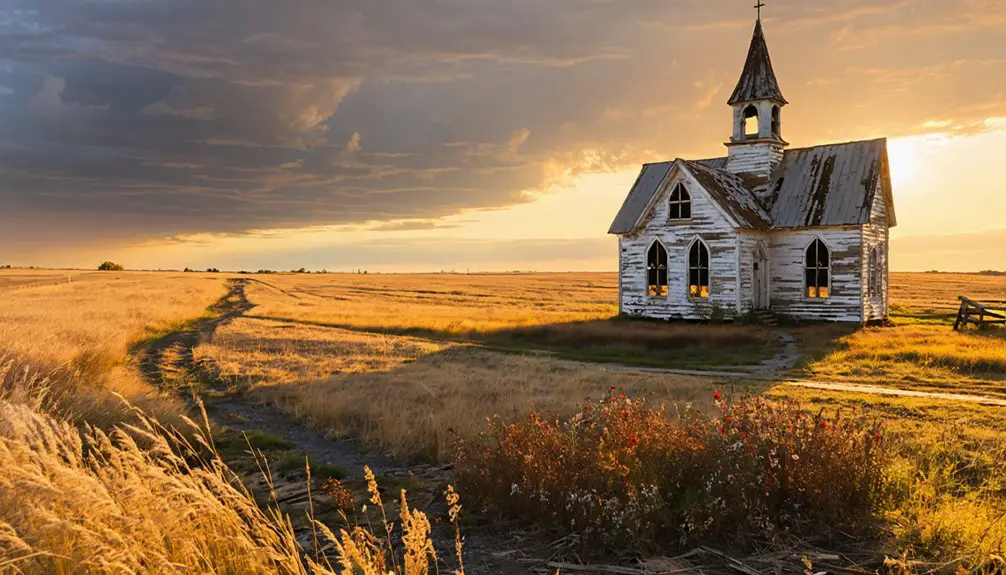
Since abandonment threatened to erase Melville’s rich history, preservation efforts led by North Dakota’s State Historic Preservation Office have worked to protect this ghost town’s legacy through various initiatives.
Community initiatives have focused on documenting Melville’s remaining structures through photography and detailed historical records, while preservation funding efforts aim to secure both public and private resources.
You’ll find interpretive signage that tells the story of this once-thriving community, along with digital archives that preserve its memory. The SHPO’s guidance has helped establish training programs and workshops for local volunteers who serve as site stewards.
Through cooperative partnerships between government agencies, historians, and preservation enthusiasts, Melville’s cultural heritage continues to be safeguarded for future generations to explore and understand.
Modern Significance and Historical Value
While many ghost towns fade into obscurity, Melville’s significance extends beyond its physical remnants as a cultural touchstone for understanding North Dakota’s railroad and settlement history.
You’ll find Melville’s story intertwined with cultural tourism and rural heritage exploration, attracting visitors who seek authentic connections to early 20th-century life. Originally named Newport after a railway official, the town’s renaming to honor Melville D. Carrington reflects the deep influence of local settlers on community identity.
- Weathered buildings stand as silent witnesses to the transformative impact of railroad expansion and agricultural mechanization.
- Heritage travelers photograph abandoned structures along U.S. routes 52 and 281, documenting the town’s evolution.
- Local historians preserve stories of railroad prosperity, rural exodus, and community resilience.
Frequently Asked Questions
Are There Any Documented Paranormal Activities or Ghost Sightings in Melville?
You won’t find documented ghostly encounters or spectral evidence in this location. Research through historical records and local knowledge doesn’t reveal any verified paranormal activity or substantiated ghost sightings worth noting.
What Was the Peak Population of Melville During Its Most Prosperous Years?
Based on Melville’s history, you’ll find records showing the town peaked at around 150 residents in 1914, before population decline set in. Though unofficial, this estimate’s supported by local historical documentation.
Did Any Notable Historical Figures Ever Visit or Live in Melville?
You won’t find any documented historical visits or notable residents in this railway stop. Beyond R.M. Newport and Melville Carrington – the railway treasurer and landowner who inspired its names – no famous figures emerge.
Which Native American Tribes Originally Inhabited the Area Before Melville’s Establishment?
You’ll find the area was primarily dominated by Sioux tribes, including Dakota, Lakota, and Nakota peoples. The Mandan culture also had a significant presence along the Missouri River before European settlement.
Are Metal Detecting or Archaeological Activities Permitted at the Melville Site?
You’ll need permits from the State Historical Society of North Dakota before conducting any metal detecting or archaeological activities. Without proper authorization, you’re violating state regulations and risking significant legal penalties.
References
- https://northernsentry.com/2025/06/26/north-dakota-ghost-towns/
- https://ghostsofnorthdakota892857007.wordpress.com/2015/10/30/true-ghost-towns-population-zero/
- https://northernsentry.com/2023/05/12/ghosts-of-north-dakota/
- https://freepages.history.rootsweb.com/~gtusa/usa/nd.htm
- https://www.youtube.com/watch?v=hRFfy3HQaus
- https://commons.und.edu/cgi/viewcontent.cgi?filename=9&article=1000&context=oers&type=additional
- https://en.wikipedia.org/wiki/History_of_North_Dakota
- https://www.sdhspress.com/journal/south-dakota-history-30-2/town-building-and-persistence-on-the-great-plains-the-case-of-presho-south-dakota/vol-30-no-2-town-building-and-persistence-on-the-great-plains.pdf
- https://www.history.nd.gov/ndhistory/settlement.html
- https://www.history.nd.gov/archives/manuscripts/inventory/10157counties/10157 Foster.html
